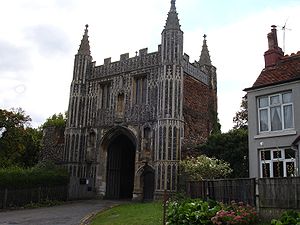
St. John's Abbey, Colchester
Encyclopedia

Benedictine
Benedictine refers to the spirituality and consecrated life in accordance with the Rule of St Benedict, written by Benedict of Nursia in the sixth century for the cenobitic communities he founded in central Italy. The most notable of these is Monte Cassino, the first monastery founded by Benedict...
monastery founded by Eudo, son of Hubert de Ria, seneschal of King William II (William Rufus) in 1096.
This particular location was chosen for the monastery by Eudo as it was believed to be the site of a supposed miracle.
History
The first Abbot was Hugh of YorkYork
York is a walled city, situated at the confluence of the Rivers Ouse and Foss in North Yorkshire, England. The city has a rich heritage and has provided the backdrop to major political events throughout much of its two millennia of existence...
, elected in 1104. Not soon after, the monastic living quarters were moved to the opposite side of the church due to the noise from the town and in October the first church was itself completed. At this point there were over twenty monks in residence.
There were two cells of the abbey; a hermitage
Hermitage (religious retreat)
Although today's meaning is usually a place where a hermit lives in seclusion from the world, hermitage was more commonly used to mean a settlement where a person or a group of people lived religiously, in seclusion.-Western Christian Tradition:...
known as Bedesmannesburg and Snape Priory in Suffolk
Suffolk
Suffolk is a non-metropolitan county of historic origin in East Anglia, England. It has borders with Norfolk to the north, Cambridgeshire to the west and Essex to the south. The North Sea lies to the east...
which seems to have often had as little as one permanent resident.
There was considerable conflict between the abbey and the town for much of its existence, common enough circumstances at the time, as for example with Cirencester Abbey
Cirencester Abbey
Cirencester Abbey in Gloucestershire was founded as an Augustinian monastery in 1117 on the site of an earlier church, the oldest-known Saxon church in England, which had itself been built on the site of a Roman structure. The church was greatly enlarged in the 14th century with addition of an...
and Wymondham Abbey
Wymondham Abbey
Wymondham Abbey is situated in the town of Wymondham in Norfolk, England.-Background:It is the Anglican parish church of Wymondham, but it started life as a Benedictine priory....
. In 1272, a riot took place at the Midsummer fair between the townspeople and men from the abbey, and a corpse was subsequently discovered which the abbey claimed to be a victim of the riot, killed by the townspeople. However it was soon discovered to be a body removed from the town gallows by the monks for the purpose of presenting him as a murder victim.
Later, even a fortified tower was constructed to defend the abbey during local conflict.
Financially and materially, the abbey was in difficulty during, and beyond, the fourteenth century, with the church known to have been damaged by both flooding and fire. During this period there was also a significant conflict, culminating in a violent riot when the canons of nearby St Boltophs Priory appear to have stormed the abbey and attacked some of the community including the abbot himself.
In 1396, a monk of the abbey, John Colschestre was appointed bishop of Orkney by the pope, who in 1399 also granted the abbots of Colchester the use of the mitre, thus enhancing their status.
In 1403, the abbot was involved in a conspiracy to restore a supposedly still living King Richard II to the throne. The plot failed and the conspirators, including the abbot were arrested, though he had by then fled. He was later pardoned but got into further trouble and was imprisoned in Nottingham Castle. He died not long after.
There were further political problems involving the community in 1534, with the abbot and other monks refusing to give the oath of fealty to Henry VIII
Henry VIII of England
Henry VIII was King of England from 21 April 1509 until his death. He was Lord, and later King, of Ireland, as well as continuing the nominal claim by the English monarchs to the Kingdom of France...
and his successors.
The Dissolution and beyond
In 1538 the order was given to suppress the abbey though this was not undertaken until the following year, by which time the abbot was under investigation for treason. Imprisoned in the Tower of London, he was subsequently found guilty and hanged for speaking out against the King, for supporting rebellion and opposing the dissolution. The abbey became the possession of the Crown and was leased to Sir Thomas Darcy in 1546.The only surviving monastic structures are that of the impressive two storey gatehouse, dating from the 15th century, and some stretches of the precinct
Precinct
A precinct is a space enclosed by the walls or other boundaries of a particular place or building, or by an arbitrary and imaginary line drawn around it. The term has several different uses...
wall. Whatever other buildings survived following the dissolution, were destroyed during the siege of 1648.

